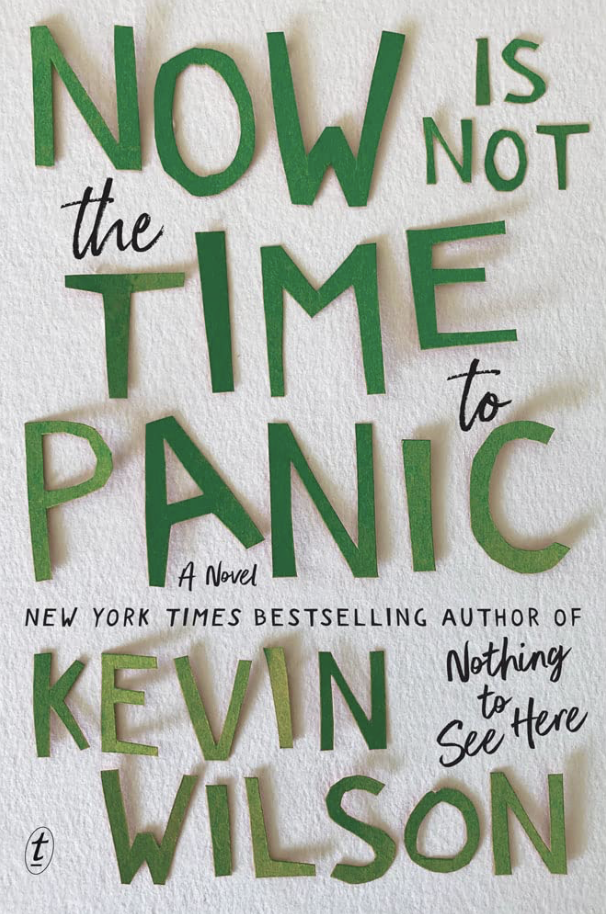Now Is Not the Time to Panic by Kevin Wilson
Now Is Not the Time to Panic (2022) is a much-anticipated title from the New York Times bestselling author of Nothing to See Here (2019), Kevin Wilson. It chronicles the events of a fateful summer brought on by two unsuspecting teenagers, Frankie and Zeke. Theirs is an awkward, clumsy coming-of-age story set against a backdrop of secrecy and the building of a national pop culture moment.
Frances Eleanor Budge is as grown up as grown ups get: she has a house, a husband and a daughter. Seemingly, everything is fine – until it isn’t. The past eventually comes crashing down around her carefully constructed facade.
Flash to twenty years earlier, when 16-year-old Frankie Budge is preparing for another summer spent babysitting, procrastinating writing her novel and doing mostly nothing all by herself when fate intervenes, and she is introduced to the awkward and equally lonely Zeke. The two become fast friends, despite Frankie’s hesitation around spending time with a boy and her crushing case of lone-wolf syndrome. Within days, they form a pact to create art all summer, and soon they have in their hands a strange poster plastered with mysterious words – and the beginnings of a wide-spread panic that ends in two deaths.
As the story unfolds, events escalate and the pair do everything in their power to become who they want to be, Frankie discovers a new-found purpose in the poster. Reflecting on that summer from the fresh threat of the present, she returns time and time again to the images drawn by Zeke, and the words written by her:
“The edge is a shantytown filled with gold seekers. We are fugitives, and the law is skinny with hunger for us.”
Contained within these words is everything Frankie aspires to be. An outsider with a purpose, someone who, even if she is a fugitive, is at least wanted. The importance of this becomes apparent with her obsession with scanning and distributing as many posters as possible, even when they threaten to throw their whole town into panic – as well as her obsessions with the phrase and that summer well into adulthood.
“And I know, in that moment, that my life is real, because there’s a line from this moment all the way back to that summer, when I was sixteen, when the whole world opened up and I walked through it.”
At its core, Now Is Not the Time to Panic is about one single sentiment, asked by Frankie within these pages:
“We were sixteen. How did you prevent your life from turning into something so boring that no one wanted to know about it? How did you make yourself special?”
This sentiment is painfully obvious in the duo’s choices – chasing something no one else has, trying to make it bigger than it is, at any cost. Wilson does a wonderful job of describing those feelings of teenagerhood that provide clarity in hindsight. They are the most crystalline moments of the novel, providing real insight to the workings of a teenager’s mind. After all, we have all been there, and Wilson knows we are in on the whole thing.
“To be a teenager, it takes very little to think that someone else might actually know who you are, even as you spend all your time thinking that no one understands you. It's such a lovely feeling.”
While the context of the summer provides ample opportunity for nuanced insight into the making of one’s identity, obsession, the purpose and power of art – and words – it fails to deliver on any of these with real depth. This novel balances on the fence between young adult and adult fiction, and it is this lack of commitment to either genre that prevents it from reaching its full potential.
As a result, while the characters are neurotic and flawed in their own way, they fail to be truly three-dimensional or relatable. Frankie’s hints at perhaps being on the spectrum are never explored further; even Zeke’s bipolar disorder is an irrelevant afterthought. Their relationship, while portraying the tentative first emotions of young love rather well, exists almost entirely outside of the main narrative, in a way that both undervalues these very much real relationships, while also overstating the permanent mark of teenage love.
Secondary characters, like Frankie’s mother and triplet brothers, or Zeke’s cheating father, are slotted in without any real purpose, and are chronically under-developed. The result is a book that feels like a cut-out of a book – the characters are there, the drama is there, the climax is there and the resolution is there – but unfortunately none of these are tied together with deeper nuance.
Now Is Not the Time to Panic is about a summer blown out of proportion – both out of desperation and by sheer accident – explored through the eyes of a narrator who continues to bear the scars of wanting to be special. Or, put more simply, it is about two teenagers, tethered to the past by a fear of being ordinary.
Fruzsina Gál is an aspiring writer, born in Hungary but living in Australia. She has been a reader all her life, and her first short story, 'The Turul' was published in Griffith University's 2018 anthology, Talent Implied. Her writing is often focussed on identity and the effects of immigration on the self. You can find her online at www.fruzsinagal.com or @thenovelconversation.
